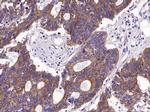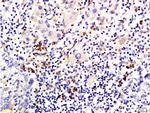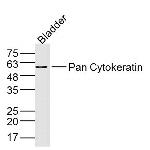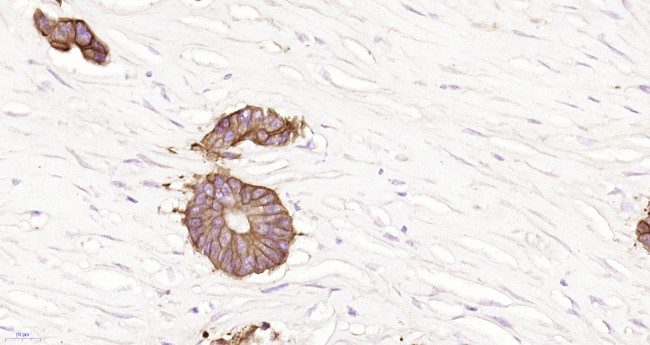Search Thermo Fisher Scientific
FIGURE: 1 / 8
pan Cytokeratin Antibody (BS-1712R) in IHC (P)








Product Details
BS-1712R
Species Reactivity
Host/Isotype
Class
Type
Immunogen
Conjugate
Form
Concentration
Purification
Storage buffer
Contains
Storage conditions
Shipping conditions
Target Information
Cytokeratins are proteins of keratin-containing intermediate filaments found in the intracytoplasmic cytoskeleton of epithelial tissue. The cytokeratins are encoded by a family encompassing 30 genes. Among them, 20 are epithelial genes and the remaining 10 are specific for trichocytes. In the cytoplasm, the keratin filaments conform a complex network which extends from the surface of the nucleus to the cell membrane. Numerous accessory proteins are involved in the genesis and maintenance of such structure. This association between the plasma membrane and the nuclear surface provides important implications for the organization of the cytoplasm and cellular communication mechanisms. Apart from the relatively static functions provided in terms of supporting the nucleus and providing tensile strength to the cell, the cytokeratin networks undergo rapid phosphate exchanges mediated depolymerization, with important implications in the more dynamic cellular processes such as mitosis and post-mitotic period, cell movement and differentiation. Cytokeratins interact with desmosomes and hemidesmosomes, thus collaborating to cell-cell adhesion and basal cell-underlying connective tissue connection.
For Research Use Only. Not for use in diagnostic procedures. Not for resale without express authorization.
References (0)
Bioinformatics
Protein Aliases: 57kd keratin; 57kDa keratin; 58 kDa cytokeratin; 67 kDa cytokeratin; caracul; CK 2e; CK-1; CK-2e; CK-4; CK-5; CK-6G; CK-7; CK-71; CK-72; CK-75; CK-78; CK-8; cytokeratin 1; cytokeratin 4; cytokeratin 5; Cytokeratin 7; cytokeratin 8; Cytokeratin endo A; cytokeratin KRT2-6HF; cytokeratin type II; Cytokeratin-1; Cytokeratin-2e; Cytokeratin-4; Cytokeratin-5; Cytokeratin-6G; Cytokeratin-7; Cytokeratin-71; Cytokeratin-72; Cytokeratin-75; Cytokeratin-78; Cytokeratin-8; Cytoskeletal 57 kDa keratin; epidermolysis bullosa simplex 2 Dowling-Meara/Kobner/Weber-Cockayne types; epidermolytic hyperkeratosis 1; Epithelial keratin-2e; Hair alpha protein; hK6hf; hK6irs; hK6irs1; K1; K2e; K4; K5; K6-irs1 keratin; K6G; K7; K71; K72; K75; K78; K8; keratin 1, type II; keratin 2 (epidermal ichthyosis bullosa of Siemens); keratin 2 epidermis; keratin 2, type II; keratin 2A; keratin 4, type II; keratin 5 (epidermolysis bullosa simplex Dowling-Meara/Kobner/Weber-Cockayne types); keratin 5 (epidermolysis bullosa simplex, Dowling-Meara/Kobner/Weber-Cockayne types); keratin 5, type II; Keratin 6 irs; keratin 6, inner root sheath, 2; keratin 7, type II; keratin 71; keratin 71, type II; keratin 72, pseudogene; keratin 72, type II; keratin 75; keratin 75, type II; keratin 78, type II; keratin 8, type II; keratin 86; keratin complex 2, basic, gene 1; keratin complex 2, basic, gene 17; keratin complex 2, basic, gene 35; keratin complex 2, basic, gene 4; keratin complex 2, basic, gene 5; keratin complex 2, basic, gene 6g; keratin complex 2, basic, gene 7; keratin complex 2, basic, gene 8; keratin complex 2, gene 17; keratin complex 2, gene 6g; keratin Kb40; keratin protein K6irs; keratin, 55K type II cytoskeletal; keratin, simple epithelial type I, K7; Keratin, type II cytoskeletal 1; Keratin, type II cytoskeletal 2 epidermal; Keratin, type II cytoskeletal 4; Keratin, type II cytoskeletal 5; Keratin, type II cytoskeletal 7; Keratin, type II cytoskeletal 71; Keratin, type II cytoskeletal 72; Keratin, type II cytoskeletal 75; Keratin, type II cytoskeletal 78; Keratin, type II cytoskeletal 8; Keratin-1; Keratin-2 epidermis; Keratin-2e; Keratin-4; Keratin-5; Keratin-5b; Keratin-6 hair follicle; Keratin-6G; Keratin-7; Keratin-71; Keratin-72; Keratin-75; Keratin-78; Keratin-8; keratinocyte associated protein 1; krt1 {ECO:0000250|UniProtKB:P04264}; krt2; krt2 {ECO:0000250|UniProtKB:P35908}; krt4 {ECO:0000250|UniProtKB:P19013}; krt5; krt7; krt7 {ECO:0000250|UniProtKB:P08729}; mK6hf; mK6irs; mK6irs1/Krt2-6g; Sarcolectin; tuftelin interacting protein 8; Type II inner root sheath-specific keratin-K6irs1; Type II inner root sheath-specific keratin-K6irs2; type II keratin Kb1; type II keratin Kb18; type II keratin Kb2; type II keratin Kb35; type II keratin Kb4; type II keratin Kb40; type II keratin Kb7; type II keratin-18; Type II keratin-K6hf; type II mesothelial keratin K7; Type-II keratin Kb1; Type-II keratin Kb18; Type-II keratin Kb2; Type-II keratin Kb34; Type-II keratin Kb35; Type-II keratin Kb4; Type-II keratin Kb40; Type-II keratin Kb5; Type-II keratin Kb7; Type-II keratin Kb8; type-II keratin-35
Gene Aliases: 2310030B04Rik; 3300001P10Rik; 4732468K03Rik; AA589387; AA589543; AA960620; AI507495; AL022697; AU019895; AW108092; AW146334; BB005427; Ca; Cal4; CARD2; CK-2e; CK-4; CK-78; CK-8; CK1; CK4; CK5; CK7; CK8; Cu; CYK4; CYK8; CYKER; D15Wsu77e; DDD; DDD1; EBS2; EHK; EHK1; EndoA; EPPK; HYPT13; K1; K2C7; K2C8; K2e; K4; K5; K5B; K6-IRS1; K6HF; K6irs; K6IRS1; K6IRS2; K7; K78; K8; Kb1; KB18; Kb2; KB34; KB35; Kb4; KB40; Kb7; KO; Krt-2.1; Krt-2.4; Krt-2.8; KRT1; KRT1A; KRT2; Krt2-1; Krt2-17; Krt2-2; Krt2-35; Krt2-4; Krt2-5; Krt2-6g; Krt2-6hf; Krt2-7; Krt2-8; KRT2A; KRT2E; KRT4; KRT5; KRT5A; KRT6; Krt6g; KRT6IRS; KRT6IRS1; KRT6IRS2; KRT7; KRT71; KRT72; Krt72-ps; KRT75; KRT78; KRT8; Krt86; KRTA; Krtcap1; KRTE; mK6irs; mK6irs1; NEPPK; PFB; Sak57; SCL; Tfip8; WSN1
UniProt ID: (Human) P04264, (Human) P35908, (Human) P19013, (Human) P13647, (Human) P08729, (Human) Q3SY84, (Human) Q14CN4, (Human) O95678, (Human) Q8N1N4, (Human) P05787, (Mouse) P04104, (Rat) Q6IMF3, (Rat) Q6IG02, (Mouse) Q3TTY5, (Mouse) P07744, (Rat) Q6IG00, (Rat) Q6P6Q2, (Mouse) Q922U2, (Mouse) Q9DCV7, (Rat) Q6IG12, (Mouse) Q9R0H5, (Mouse) Q6IME9, (Rat) Q6IG04, (Mouse) Q8BGZ7, (Rat) Q6IG05, (Rat) Q10758, (Mouse) P11679
Entrez Gene ID: (Human) 3848, (Pig) 100049664, (Human) 3849, (Pig) 100049665, (Human) 3851, (Pig) 100157675, (Pig) 100511564, (Human) 3852, (Human) 3855, (Human) 112802, (Human) 140807, (Human) 9119, (Pig) 110260666, (Human) 196374, (Pig) 100152077, (Human) 3856, (Mouse) 16678, (Rat) 300250, (Rat) 406228, (Mouse) 16681, (Mouse) 16682, (Rat) 315323, (Rat) 369017, (Mouse) 110308, (Mouse) 110310, (Rat) 300242, (Rat) 683613, (Mouse) 56735, (Mouse) 105866, (Rat) 406227, (Mouse) 109052, (Rat) 300247, (Rat) 315324, (Mouse) 332131, (Rat) 25626, (Mouse) 16691, (Pig) 100525745, (Pig) 733618

Performance Guarantee
If an Invitrogen™ antibody doesn't perform as described on our website or datasheet,we'll replace the product at no cost to you, or provide you with a credit for a future purchase.*
Learn more
We're here to help
Get expert recommendations for common problems or connect directly with an on staff expert for technical assistance related to applications, equipment and general product use.
Contact tech support
